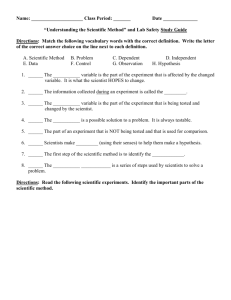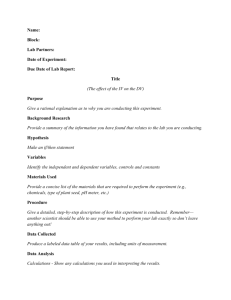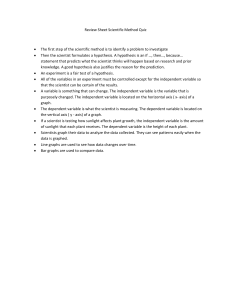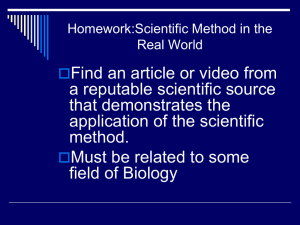Scientific Method Reading.doc
advertisement
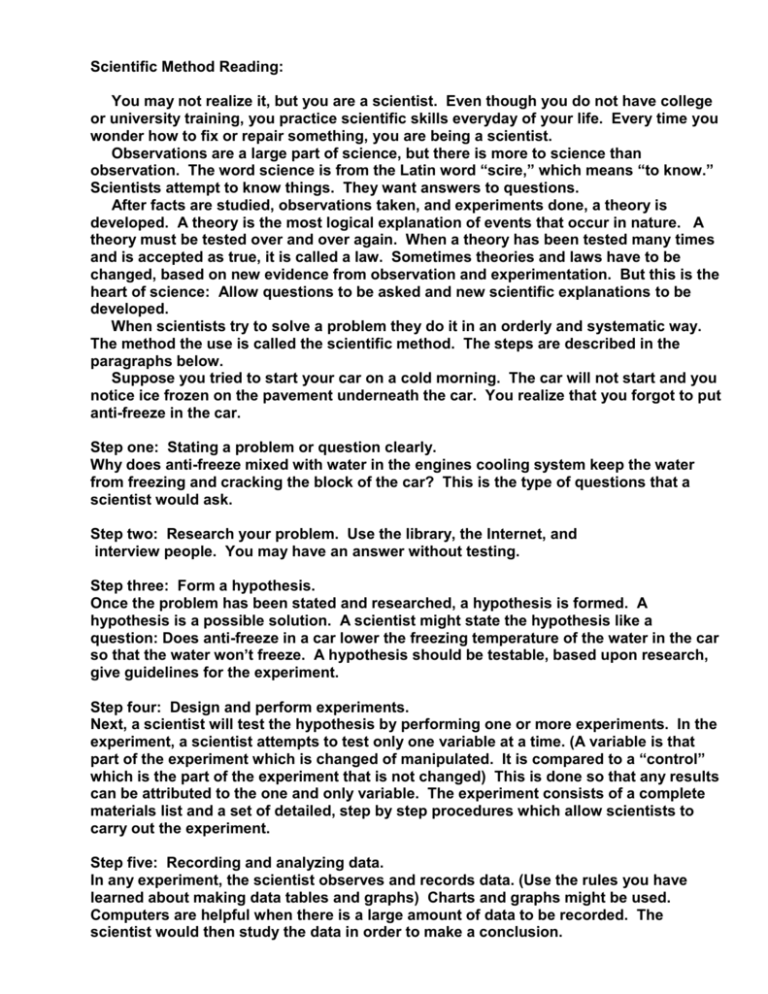
Scientific Method Reading: You may not realize it, but you are a scientist. Even though you do not have college or university training, you practice scientific skills everyday of your life. Every time you wonder how to fix or repair something, you are being a scientist. Observations are a large part of science, but there is more to science than observation. The word science is from the Latin word “scire,” which means “to know.” Scientists attempt to know things. They want answers to questions. After facts are studied, observations taken, and experiments done, a theory is developed. A theory is the most logical explanation of events that occur in nature. A theory must be tested over and over again. When a theory has been tested many times and is accepted as true, it is called a law. Sometimes theories and laws have to be changed, based on new evidence from observation and experimentation. But this is the heart of science: Allow questions to be asked and new scientific explanations to be developed. When scientists try to solve a problem they do it in an orderly and systematic way. The method the use is called the scientific method. The steps are described in the paragraphs below. Suppose you tried to start your car on a cold morning. The car will not start and you notice ice frozen on the pavement underneath the car. You realize that you forgot to put anti-freeze in the car. Step one: Stating a problem or question clearly. Why does anti-freeze mixed with water in the engines cooling system keep the water from freezing and cracking the block of the car? This is the type of questions that a scientist would ask. Step two: Research your problem. Use the library, the Internet, and interview people. You may have an answer without testing. Step three: Form a hypothesis. Once the problem has been stated and researched, a hypothesis is formed. A hypothesis is a possible solution. A scientist might state the hypothesis like a question: Does anti-freeze in a car lower the freezing temperature of the water in the car so that the water won’t freeze. A hypothesis should be testable, based upon research, give guidelines for the experiment. Step four: Design and perform experiments. Next, a scientist will test the hypothesis by performing one or more experiments. In the experiment, a scientist attempts to test only one variable at a time. (A variable is that part of the experiment which is changed of manipulated. It is compared to a “control” which is the part of the experiment that is not changed) This is done so that any results can be attributed to the one and only variable. The experiment consists of a complete materials list and a set of detailed, step by step procedures which allow scientists to carry out the experiment. Step five: Recording and analyzing data. In any experiment, the scientist observes and records data. (Use the rules you have learned about making data tables and graphs) Charts and graphs might be used. Computers are helpful when there is a large amount of data to be recorded. The scientist would then study the data in order to make a conclusion. Step Six: Stating a conclusion. A scientist will run an experiment over and over again. When the data seem to be accurate, a conclusion can be reached. A conclusion states whether or not the hypothesis was correct. A conclusion also includes an analysis of errors which occurred during the experiment. After a conclusion has been reached, there are usually other questions that arise. And the scientific method is used again to answer these new questions. Questions over reading: 1. What is a theory that is accepted as true called? 2. What is the name of the process that scientists use to solve problems? 3. What is a hypothesis? 4. Why should there be only one independent variable in an experiment? 5. What is a control used for in an experiment? 6. An experiment should consist of what two things? 7. What are recorded observations called? 8. List the steps of the scientific method in order. 9. When can a conclusion be made? 10. Using the following words, write an essay describing how new evidence can change an existing theory: data variable scientific method hypothesis control experiments conclusions
